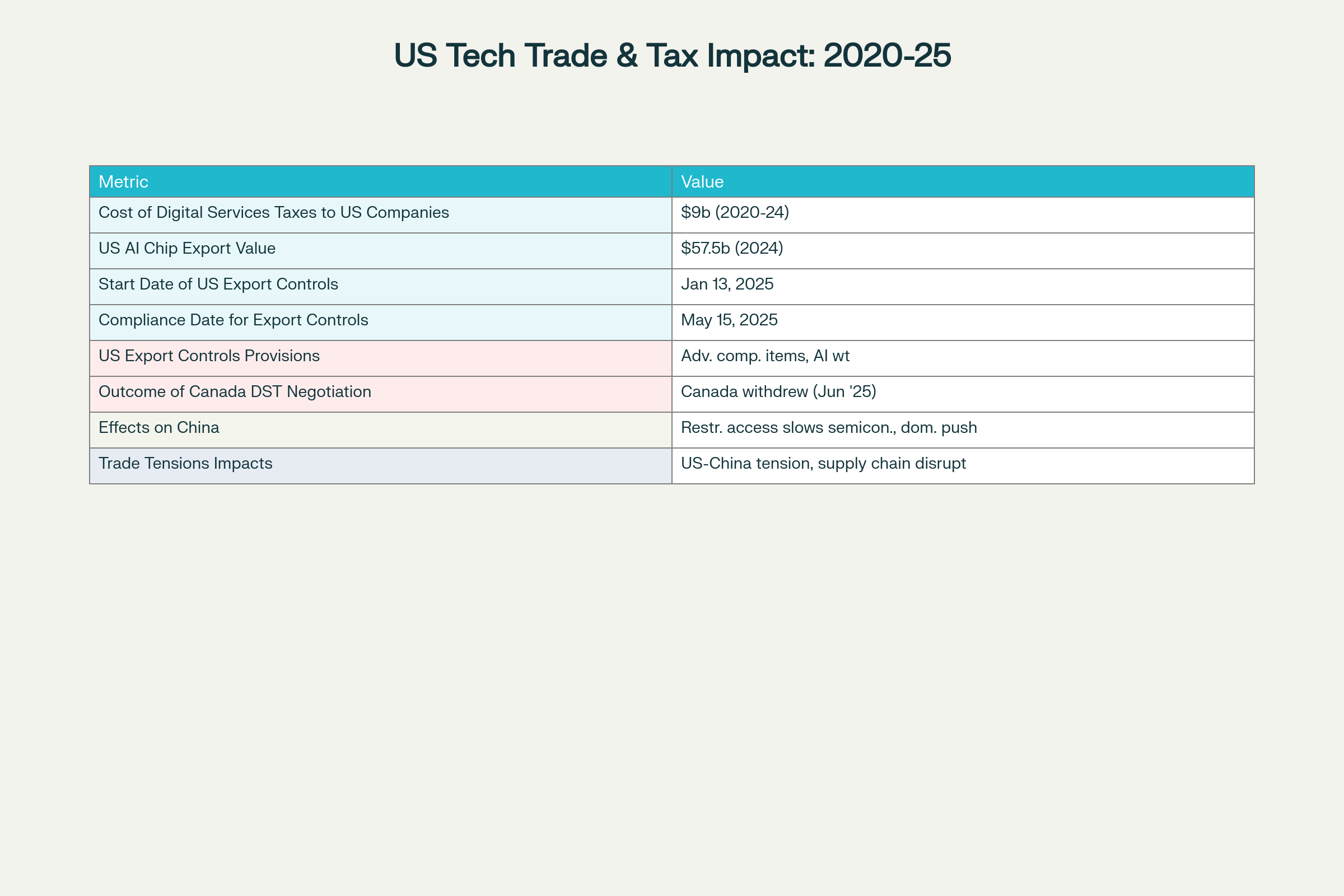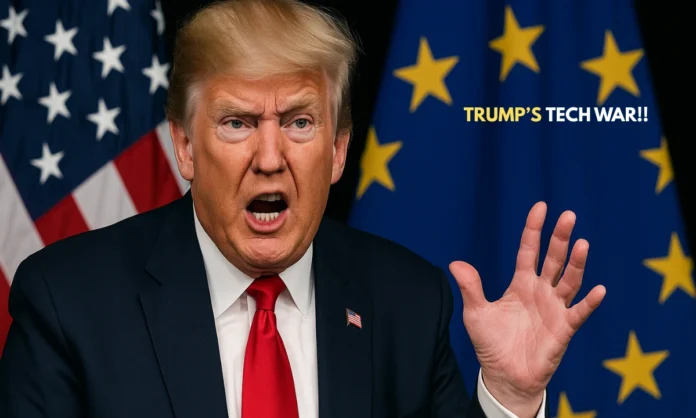Key Highlights:
- US President Donald Trump threatened to impose “substantial” tariffs on countries with digital services taxes targeting American tech companies
- Trump announced plans to restrict exports of advanced US technology and semiconductors to nations with discriminatory digital tax policies
- The warning comes after Trump successfully pressured Canada to withdraw its digital services tax in June 2025
Opening Context
President Donald Trump has escalated his campaign against international digital services taxes by issuing a stark ultimatum to global trade partners on August 26, 2025. In a forceful Truth Social post, Trump threatened to impose “substantial additional tariffs” and restrict exports of advanced technology to any nation maintaining digital services taxes targeting American tech giants. This aggressive stance marks Trump’s most comprehensive threat yet against digital services taxes, combining traditional tariff weapons with cutting-edge technology export restrictions to protect US tech companies from what he characterizes as discriminatory foreign policies.
The President’s warning specifically targets digital services taxes, digital services legislation, and digital markets regulations that he claims “are all designed to harm or discriminate against American Technology”. Trump’s ultimatum extends beyond tariffs to include export restrictions on “Highly Protected Technology and Chips,” signaling a multi-pronged approach that could reshape global trade relationships and technology supply chains. This development represents a significant escalation in ongoing trade tensions, particularly as these digital taxes have cost US companies over $9 billion from 2020-2024 according to industry calculations.
BREAKING: Trump threatens more tariffs for countries with digital taxes
— Steve Guest (@SteveGuest) August 26, 2025
“Sources said earlier that the Trump administration was considering imposing sanctions on European Union or member state officials responsible for implementing the bloc's landmark Digital Services Act.”… pic.twitter.com/FCpYNjSsEo
Trump’s Strategic Position Against Digital Services Taxes
– Trump argues that digital services taxes unfairly target American tech companies while exempting Chinese competitors
– The President claims these policies represent discrimination against US technology leadership
Trump’s opposition to digital services taxes centers on what he perceives as systematic discrimination against American technology companies. In his Truth Social statement, Trump declared that digital taxes “outrageously, give a complete pass to China’s largest Tech Companies” while targeting American firms like Alphabet, Meta, and Amazon. This positioning frames the issue as not merely about tax policy but about maintaining America’s technological dominance in global markets.
The President’s argument gains credibility from the structure of existing digital services taxes, which primarily affect US giants due to their market positions. Countries like France, the UK, Spain, and Italy have implemented these taxes specifically targeting large technology platforms, most of which happen to be American companies. Trump’s framing suggests these taxes represent unfair trade practices rather than legitimate revenue-raising measures, justifying his threatened retaliation through tariffs and export restrictions.
Trump’s stance also reflects broader concerns about technological competition with China. By highlighting that digital services taxes exempt Chinese tech companies while burdening American firms, Trump positions these taxes as inadvertently strengthening US rivals. This narrative supports his broader “America First” technology agenda, where protecting US tech companies becomes synonymous with maintaining national technological superiority in global competition.
Comprehensive Threat Matrix: Tariffs Plus Export Controls
– Trump combines traditional tariff threats with modern technology export restrictions
– Export controls would target advanced semiconductors and protected technologies
Trump’s threat represents an unprecedented combination of economic weapons against countries maintaining digital services taxes. Beyond traditional tariffs, Trump announced plans to “institute Export restrictions on our Highly Protected Technology and Chips”. This dual approach reflects the evolving nature of economic warfare, where technology access becomes as powerful as market access in influencing foreign policy decisions.
The export restriction component carries particular weight given recent US actions in this sphere. In January 2025, the US Department of Commerce implemented comprehensive export controls on advanced computing items and artificial intelligence model weights, with compliance required by May 15, 2025. These controls already restrict access to cutting-edge semiconductors and AI technologies, demonstrating the US government’s willingness to use technology exports as diplomatic leverage.
The semiconductor industry represents a critical vulnerability for many nations dependent on US technology. With US AI chip exports valued at $57.5 billion in 2024, restricting access to these technologies could significantly impact countries’ technological development and competitiveness. Trump’s threat to extend these restrictions to nations with digital services taxes creates a powerful incentive for policy changes, as demonstrated by Canada’s withdrawal of its digital services tax following US pressure in June 2025.

Global Trade Impact and Strategic Implications
– Trump’s ultimatum could reshape international trade relationships and technology supply chains
– The threat follows successful pressure on Canada to withdraw its digital services tax
Trump’s ultimatum carries far-reaching implications for global trade relationships and technological cooperation. The President’s success in pressuring Canada to withdraw its digital services tax demonstrates the effectiveness of combining trade threats with diplomatic pressure. This precedent suggests that other nations may face similar choices between maintaining their digital tax policies and preserving access to US markets and technology.
The European Union faces particular pressure given its comprehensive digital markets regulations and various member states’ digital services taxes. The recent joint statement between the US and EU promising to “address unjustified trade barriers” indicates ongoing negotiations, but Trump’s ultimatum suggests limited patience for extended discussions. European nations must now weigh the revenue from digital services taxes against potential tariffs on their exports and restricted access to US technology.
The broader implications extend beyond immediate trade relationships to global technology governance. Countries implementing digital services taxes may accelerate efforts to develop domestic technology alternatives, similar to China’s response to US export restrictions. This could fragment global technology markets and reduce the interconnected nature of digital infrastructure, potentially undermining the efficiency and innovation benefits of global technology integration.
Enforcement Mechanisms and Economic Consequences
– Trump’s threats carry significant economic consequences for targeted nations
– Export restrictions could disrupt global semiconductor supply chains and technological development
The enforcement of Trump’s threatened measures would operate through established US trade and export control mechanisms. The US Trade Representative could initiate Section 301 investigations against countries with digital services taxes, leading to retaliatory tariffs on their exports. Simultaneously, the Department of Commerce could expand export licensing requirements for advanced technologies, similar to existing controls implemented against China.
The economic consequences of these combined measures could be severe for targeted nations. Export restrictions on advanced semiconductors and AI technologies would particularly impact countries’ technological development and competitiveness. Chinese semiconductor firms already face significant hurdles in chip design due to US export controls, slowing progress in high-performance computing and AI development. Extending similar restrictions to allies with digital services taxes could create widespread technological disruption.
The global semiconductor supply chain would face additional fragmentation under Trump’s proposed measures. Companies like Synopsys and Cadence, which provide essential electronic design automation software, could lose access to major markets if export restrictions expand. This fragmentation would likely accelerate efforts by affected countries to develop domestic alternatives, potentially reducing US technological influence while increasing development costs and timelines globally.
Closing Assessment
Trump’s ultimatum on digital services taxes represents a watershed moment in international trade policy, combining traditional protectionist measures with cutting-edge technology export controls to defend American tech companies. The President’s success in forcing Canada to abandon its digital services tax demonstrates the effectiveness of this multi-pronged approach, while his threats against other nations signal an escalation in global trade tensions that could fundamentally reshape international economic relationships.
The broader implications extend far beyond tax policy to questions of technological sovereignty and economic interdependence. Countries must now weigh the benefits of digital services taxes against the risks of losing access to US markets and advanced technologies. As Trump declared, American technology companies are “neither the ‘piggy bank’ nor the ‘doormat’ of the World any longer”, signaling a more aggressive defense of US technological interests that could define international trade relationships for years to come.


